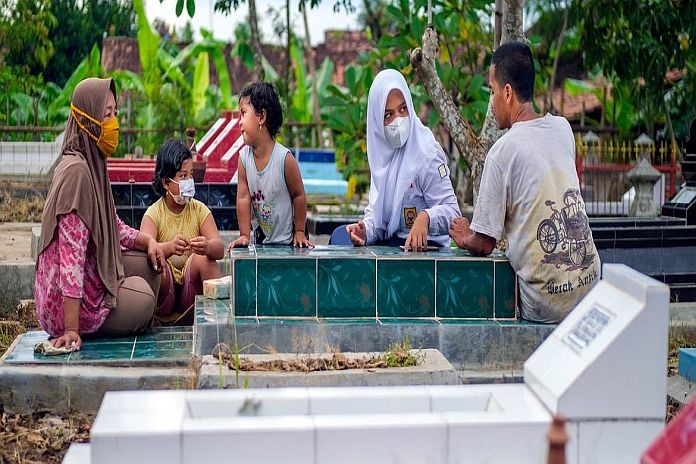GENEVA, Switzerland – The world must accept that COVID-19 is with us “for the foreseeable future”, even if it is possible to end the acute phase of the pandemic this year, UN health agency chief, Tedros Adhanom Ghebreyesus, said on Monday.
Speaking in Geneva, World Health Organization (WHO) director-general Tedros noted that on average last week, 100 cases were reported every three seconds, and somebody lost their life to the coronavirus every 12 seconds.
It is still “dangerous to assume that Omicron will be the last variant, or that we are in the endgame” of the pandemic, he said.
“On the contrary, globally, the conditions are ideal for more variants to emerge,” Tedros insisted, exactly two years and a day since he declared the deadly virus a public health emergency of international concern.

Emergency phase
Also on Monday, the WHO’s top European official said that although the SARS-CoV-2 crisis was far from over, he was “hopeful” of seeing the end of the “emergency” phase in 2022.
“While Omicron appears to cause much less severe disease than Delta, we are still seeing a rapid rise in hospitalizations, due to the sheer number of infections,” said Dr Hans Kluge, WHO regional director for Europe.
“This is in addition to a Delta burden that has not entirely passed, and also to the high number of incidental admissions. Fortunately, hospitalizations with Omicron result much less frequently in intensive care unit admission. As predicted, most people needing intensive care across the region are unvaccinated.”
Future-proofing
In an appeal to WHO Member States, Tedros said that their top priorities should be to stop future health threats from taking hold and causing such massive disruption to “health systems, economies and societies the world over”.
To do this, all States should promote health and wellbeing, “preventing disease by addressing its root causes”, he said, in a call for a renewed focus on primary healthcare for everyone.
On tackling the coronavirus specifically, Tedros urged better management of acute respiratory diseases, via a “sustained and integrated” international platform, to coordinate preparedness against future pandemics.
Under-reported deaths
Two years into the pandemic, with almost 350 million cases reported and more than 5.5 million deaths – numbers known to be an “underestimate” – Tedros insisted that many other measures needed to be implemented to protect the most vulnerable.
“Learning to live with COVID cannot mean that we give this virus a free ride,” he noted. “It cannot mean that we accept almost 50,000 deaths a week, from a preventable and treatable disease. It cannot mean that we accept an unacceptable burden on our health systems, when every day, exhausted health workers go once again to the front line.”
Repeating his call for all countries to vaccinate 70 percent of their populations to help bring an end to the acute phase of the pandemic, the WHO director-general said that 86 States across all regions had been unable to reach last year’s target of vaccinating 40 percent of their populations.
Vaccine have-nots
More than 30 countries – mostly in Africa and the Eastern Mediterranean – have not vaccinated even 10 percent of their populations and 85 percent of people in Africa have yet to receive a single dose of vaccine.
While vaccines remain a key part of the COVID-19 exit strategy, Tedros re-emphasised the importance of equitable access to diagnostics, oxygen and antivirals, too.
Much better testing and sequencing of the virus was also needed, the WHO chief explained, “to track the virus closely, and monitor the emergence of new variants”.
On a positive note, Tedros insisted that progress was being made to tackle long-running treatment disparities, thanks to the UN-partnered COVAX initiative, which had delivered its one billionth dose just a week ago, and which had also shipped more vaccines in the past ten weeks “than in the previous ten months combined”.
Misinformation threat
Also at WHO headquarters on Monday, top agency officials warned of the ongoing challenges posed to national vaccination campaigns as a direct result of wilful misinformation about COVID-19 jabs and treatment.
“I think we have to acknowledge this is not an issue that is immediately solvable, and I think there is a very high concern that disinformation and the undermining of evidence and data and science, may come out of this having even greater impact on some of the other essential preventive programmes,” said WHO immunization director Dr Kate O’Brien.
To tackle false information, WHO encourages community and faith leaders to present an accurate and science-based view of the pandemic and its risks.
The UN health agency also works with large social media platforms to issue warnings over posts that are not factual, based on policies that have been developed to target unfounded rumours.
“This is a huge problem that we’ve been dealing with, not just with vaccines but with vaccines but throughout this entire pandemic,” said Dr Maria van Kerkhove, WHO COVID-19 Technical Lead. “Disinformation-misinformation kills and it travels faster than viruses…We really need people to pass good information to each other.”





